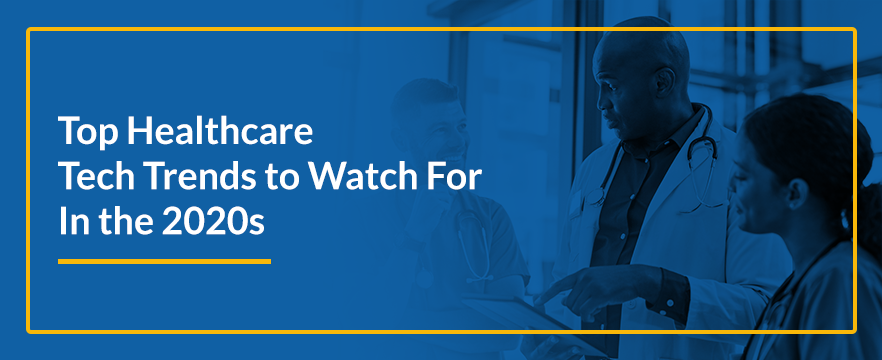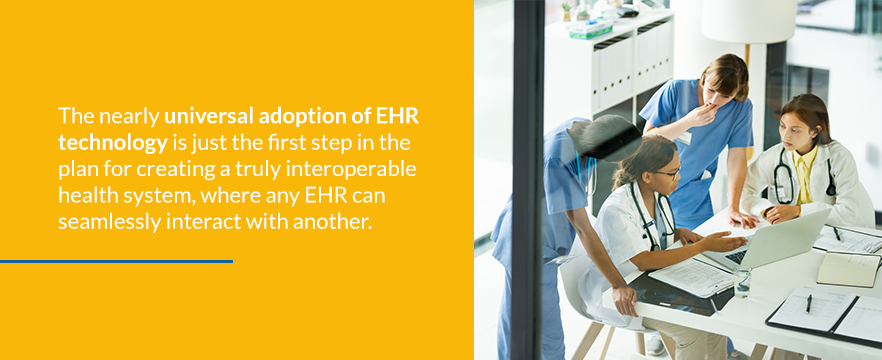Top Healthcare Tech Trends to Watch For In the 2020s
Jan 16, 2020 | Jonathan Maisel
Healthcare has always been a field shaped by constant innovation. The recent acceleration of technological development has given rise to the new sub-field of “health tech,” or the use of technology to improve healthcare administration and patient outcomes.
There are a number of technology healthcare trends that are changing the landscape of the industry. In this guide, we’ll discuss recent healthcare technology trends and which are most likely to disrupt the industry in the years to come.
Top Unusual Healthcare Tech Trends to Watch
Some healthcare technology trends are more unusual than others. Here are some of the most exciting ways health tech trends are altering the way we approach medical care:
1. Applied Use of Artificial Intelligence
Artificial intelligence (AI) has been a technology of note for some time, but its actual use has been limited in the healthcare field until now. A growing body of research suggests AI is just as good as or better than humans in critical healthcare activities, like diagnosing illness. For instance, algorithms are already better than radiologists at identifying malignant tumors. The coming years will likely see AI working alongside humans to provide better care.
2. Consumer Devices as Medical Monitors
Recently, several people’s lives have been saved by smartwatches that detected issues with the user’s heart rate or blood pressure. Companies like Apple are increasingly working with healthcare institutions to integrate data from consumer devices directly into providers’ EHRs.
3. Use of IT to Increase Patient Engagement
Empowering patients to take charge of and manage their own health is a central goal for providers, and friendlier interfaces are a big part of that push. With easy-to-use patient portals appearing in EHRs, patients can easily interact with their own health data to make better decisions regarding care.
Top Practical Healthcare Tech Trends to Watch
While some developments make a big splash, like AI application in diagnosis, other healthcare tech trends are focused on improving care delivery for clinicians:
1. Increased Use of Telehealth Services
Telehealth connects healthcare providers with patients through telecommunications like videoconferencing and remote monitoring. This form of healthcare delivery is crucial for increasing access to care in underserved areas, and today 76 percent of hospitals in the U.S. provide some form of telehealthcare. With better monitoring through personal consumer devices, telehealth is expected to grow even further.
2. Improved Interoperability
The nearly universal adoption of EHR technology is just the first step in the plan for creating a truly interoperable health system, where any EHR can seamlessly interact with another. The Office of the National Coordinator for Health Information Technology (ONC) created a 10-year roadmap for interoperability that will take us through 2024. This roadmap will guide the development of health information technology for the next several years, pushing vendors to create solutions that work across health systems.
3. Continued Focus on Protecting Healthcare Data
As patient data continues to be digitized, the threat of data breaches remains critical. Healthcare is the sector most affected by data breaches, making it even more essential for new products to meet high security standards.

Top Out-Of-The-Box Trends to Watch
Out of the box software solutions will keep making great strides, thanks to trends like:
1. EHR Optimization
Although EHRs have come a long way since their initial adoption, they still have a ways to go before doctors are completely satisfied with using them. According to one poll, 62 percent of the time allotted to each patient is spent on the EHR, 71 percent of physicians agree their EHR contributes to burnout and 59 percent of physicians believe EHRs as a whole need a complete overhaul.
EHRs improve diagnostics and patient outcomes, but in some cases, it can be at the expense of doctors’ time and mental health. The next phase of EHR development will focus on creating systems that ease the documentation burden on physicians while maintaining quality of care.
2. Increased Clinical Decision Support
EHRs are transitioning from a mirror of paper records mostly used for storage purposes to a technology that can actually help clinicians make treatment decisions. For instance, tools like e-prescribing are already helping prescribing clinicians avoid adverse drug interactions, and more complex forms of clinical decision support (CDS) are becoming more commonplace.
One study found that combining a CDS system with data pulled from genetic testing reduced re-admissions by 52 percent and reduced emergency room visits by 42 percent. In time, we can expect tools like these to become even more accessible.
3. Leveraging Augmented and Virtual Reality
The use of augmented reality (AR) and virtual reality (VR) shows great promise for medical training and making surgeries safer. More and more vendors are creating AR and VR software that allows physicians and surgeons to visualize what they are treating to improve outcomes.
Other examples of leveraging AR and VR in the healthcare space include helping patients visualize and describe their symptoms better, and assisting nurses with intravenous injections by projecting veins on top of the patient’s skin.
Digital Medical Transcription: A Top Healthcare Tech Trend
One of the health tech trends that still shows no sign of slowing down is digital medical transcription. Although EHRs are on their way to becoming optimized for physicians, the burden of providing robust documentation required for better insurance reimbursement and meeting meaningful use is simply too much for doctors to handle on their own.
Mobile-friendly, dictation-based medical transcription services allow doctors to untether themselves from the EHR and provide more meaningful face-to-face time to their patients. Physicians use a smartphone app or handheld recorder to dictate their notes, leading to a more natural and comprehensive record of every appointment. Once the dictation is complete, the physician sends the file to the service to be transcribed, eliminating the need for editing while retaining peak accuracy.
A trend within digital medical transcription is EHR integration. Using a medical transcription service with EHR integration means one less step is required in creating documentation, as the transcribed record is automatically inserted into the correct section of the EHR. The convenience of this feature greatly helps offset the current weaknesses of EHR systems, allowing clinicians to reap the benefits of digital record capture without the drawback of data entry.

Maximize Your EHR Investment Today with ZyDoc
Pointing and clicking to create documentation in an EHR is tedious, and it takes away from the doctor-patient relationship. ZyDoc offers medical transcription services that are 61 percent faster than typing and clicking, and 38 percent more accurate than speech recognition. With the simple, intuitive interface from ZyDoc, doctors can speak their notes naturally and have highly accurate records inserted automatically into their EHR within two hours in most cases.
Interested in seeing how ZyDoc improves the critical process of creating clinical documentation? Browse our service plans designed to streamline your workflow, and sign up for a free 14-day trial to find out what ZyDoc can do for you.
